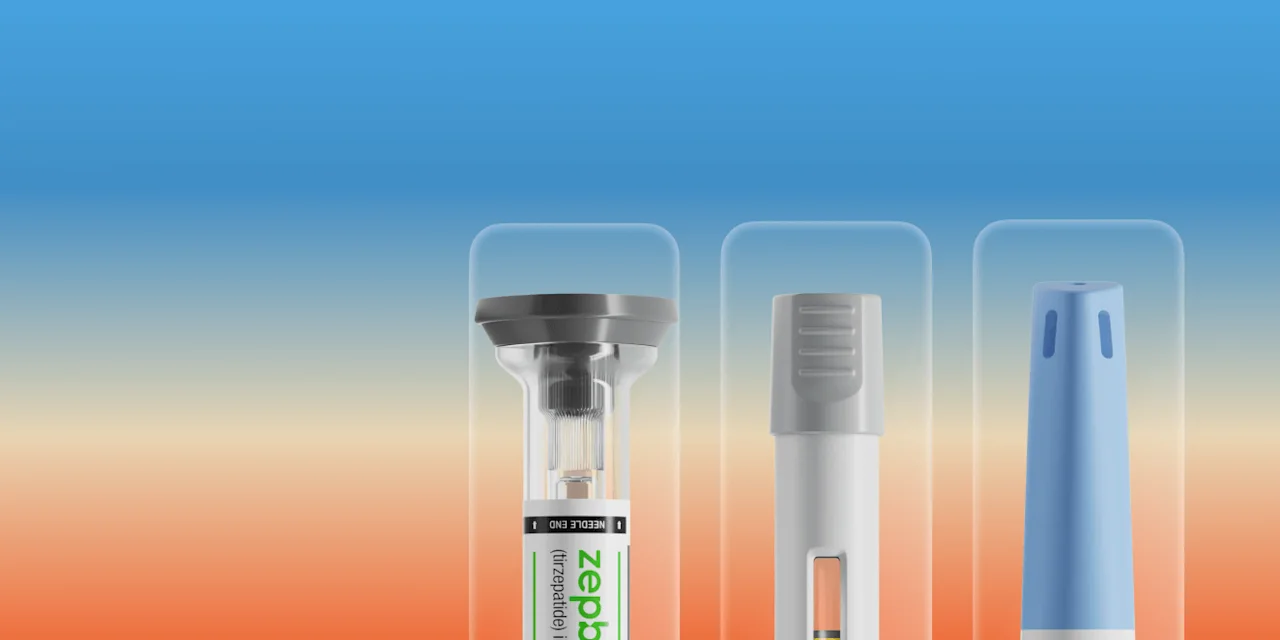Here's what we'll cover
Here's what we'll cover
Trulicity (dulaglutide) is an injectable prescription medication that treats type 2 diabetes mellitus. Currently, Trulicity is FDA-approved to help people with type 2 diabetes control their blood sugar levels, and, in those who also have heart disease, reduce the risk of experiencing a cardiovascular event like a heart attack or stroke.
While Trulicity is not FDA-approved for weight loss, it has been shown to lead to significant weight loss in people who are overweight or obese, and may be prescribed off-label for weight management. Read on as we explore how Trulicity works for weight loss, the side effects you can expect, and everything else you need to know about taking Trulicity to lose weight.
Does Trulicity work for weight loss?
Trulicity (dulaglutide) is a prescription drug that, in combination with lifestyle changes like diet and exercise, helps manage blood glucose levels in people with type 2 diabetes. Trulicity also helps reduce the risk of heart attack or stroke in people who have both type 2 diabetes and heart disease. Trulicity is not insulin, and it does not treat type 1 diabetes.
Clinical trials have shown dulaglutide effectively reduces blood glucose levels when used on its own, as well as when combined with other diabetes drugs such as metformin. Five-year follow-ups show that it also significantly reduces the incidence of a heart attack, stroke, or death from heart attack in people with type 2 diabetes and existing heart disease.
In addition to these benefits, people taking Trulicity experience a significant reduction in body weight. As a GLP-1 receptor agonist, Trulicity slows gastric emptying (the passing of food through your stomach to your intestines). At the same time, it also decreases hunger and appetite. As a result, people using Trulicity may lose weight.
Higher doses of Trulicity tend to lead to more weight loss than lower doses of the drug.
A 2021 trial compared average weight loss among individuals who had type 2 diabetes and were already taking metformin. Nine months after starting treatment with dulaglutide, those taking the highest 4.5 mg dose lost a little over 10 pounds (4.6kg), on average, compared with almost 9 pounds (4kg) for those taking the 3.0 mg dose and 6.5 pounds (3kg) for those taking the 1.5 mg dose. By the end of the year, they lost even more weight.
While higher doses of Trulicity lead to more weight loss, weight loss can occur at lower doses as well. In a clinical trial, those taking 1.5 mg of dulaglutide lost about 5 pounds within six months of starting treatment. They also lost more weight than those taking metformin alone (another diabetes medication). A 2021 study measured the effects of switching from insulin to dulaglutide as a first-line treatment for type 2 diabetes. Over a period of six months, the participants experienced significant improvements in their HbA1c levels and body weight, especially if they had a higher HbA1c baseline to begin with.
How does Trulicity work for weight loss?
Trulicity is not approved for weight loss, but people using Trulicity often experience weight loss as a result, thanks to how the drug works.
Trulicity belongs to a class of drugs known as glucagon-like peptide-1 (GLP-1) receptor agonists. This class of drugs also includes semaglutide, better known as Ozempic and Wegovy. GLP-1 medications work by mimicking a hormone produced by your body known as GLP-1. GLP-1 is an incretin hormone. Incretins get released after you eat to boost insulin production, which in turn, brings blood sugar levels back down.
In people with type 2 diabetes, this incretin effect doesn’t work as well as it should, or may be absent altogether, leading to blood sugar spikes. With the help of GLP-1 drugs like Trulicity, however, people with type 2 diabetes can better manage their blood sugar levels.
GLP-1 agonists target various aspects of the incretin system, all of which can benefit people with type 2 diabetes. For example, these drugs increase the production of insulin and decrease the production of glucagon, helping keep blood sugar levels in check. GLP-1 medications also slow down digestion and the rate at which food moves through your stomach to your intestine, so people using them start feeling full sooner, and for longer — which can lead to weight loss.
Trulicity side effects
The most common side effects of Trulicity include nausea, diarrhea, vomiting, abdominal pain, decreased appetite, indigestion, and fatigue. Less common side effects may include constipation, flatulence, bloating, acid reflux, and burping.
Side effects tend to be dose-dependent, meaning that they are more likely with higher doses of Trulicity. Typically, side effects are mild to moderate. Severe side effects are rare, but possible, and may cause some people to stop treatment.
Side effects like nausea are most common when starting Trulicity or when increasing your dose. Fortunately, they usually go away within a few weeks. To relieve nausea, Eli Lilly, the manufacturer of Trulicity, recommends the following:
Eating smaller meals
Avoiding fatty foods
Eating bland foods like crackers, rice, and toast
No longer eating once you feel full
People with certain medical conditions may be at increased risk of experiencing serious side effects or complications while taking Trulicity. Tell your healthcare provider if you have a history of any of the following risk factors, so they can prescribe you another medication or take appropriate cautions when titrating your dose of Trulicity:
Medullary thyroid carcinoma (a type of thyroid cancer)
Multiple Endocrine Neoplasia syndrome type 2
Pancreatitis (inflammation of the pancreas)
Acute kidney injury
Severe gastrointestinal disease
Diabetic retinopathy (diabetes-related vision loss or changes)
Pregnancy or breastfeeding
Allergy to dulaglutide or the ingredients in Trulicity
Also, tell your health provider about any other medications you are taking before starting Trulicity. Because Trulicity delays gastric emptying, it can slow down your body’s absorption of other medications, and they might not work as well.
How to take Trulicity
Trulicity is an injectable medication and comes in a pen. Each pen is pre-filled with a single dose of the medication. Once a week, you inject Trulicity subcutaneously (under the skin) into your abdomen, thigh, or upper arm. You can inject Trulicity any time of the day, regardless of when you last ate. Each time, you’ll want to rotate the injection site. So, as an example, if you injected Trulicity into your upper arm last week, this week you could inject it into your thigh, and the following week you would inject it into your abdomen.
Trulicity is available in four dosages: 0.75 mg, 1.5 mg, 3 mg, and 4.5 mg. Your healthcare provider will give you a schedule outlining your dosing regimen. Initially, you will start at 0.75 mg, before increasing to 1.5 mg. If you respond well to Trulicity, your healthcare provider may recommend increasing to 3 mg. The highest dose of Trulicity is 4.5 mg. In between each dose increase, you can expect to spend at least four weeks on the current dose before escalating to the next level.
If you miss a dose of Trulicity or want to change the day of the week you inject Trulicity, talk to a healthcare professional and follow their medical advice.
Trulicity cost
The list price of Trulicity is $930.88 per month. The list price describes the price at which Eli Lilly, the manufacturer of Trulicity, sells the drug to wholesalers. The actual price you pay at the pharmacy can be higher or lower, depending on your insurance coverage, the pharmacy you use, and the condition you’re using Trulicity to treat.
Without insurance, you will likely pay something close to the list price, or higher, depending on your pharmacy. You may be able to find pharmacy-specific coupons for Trulicity by searching online on websites like GoodRx or SingleCare. Currently, Trulicity is only available as a brand-name drug, and there is no cheaper, generic version available.
With private insurance (be it purchased independently or available through your employer), you’ll likely pay much less for Trulicity. According to Eli Lilly, over 90% of Trulicity prescriptions cost less than $30 per month, and the remaining cost is $239 on average per month. Eli Lilly also offers a Trulicity Savings Card for people with commercial drug insurance. The Trulicity Savings Card is good for up to a year’s supply of Trulicity and can bring the monthly cost of Trulicity down to as low as $25 for a three-month supply of Trulicity.
For people with prescription drug coverage through Medicare Part D, the cost of Trulicity ranges from $0 to $100 per month for about 70% of prescriptions, and around $207 per month for the other 30% of prescriptions. If you have Medicaid coverage, you can find the copay for Trulicity through your state’s Medicaid website.
It is important to note that the copays noted above are for Trulicity when it is prescribed to improve blood sugar control in people with type 2 diabetes, or to reduce cardiovascular risk in people with type 2 diabetes and heart disease. If you are prescribed Trulicity off-label for weight loss, it may not be considered a covered condition and you may have to pay the full list price.
Trulicity alternatives
Trulicity is one of several GLP-1 medications, including Byetta and Bydureon (exenatide), Victoza (liraglutide), Tanzeum (albiglutide), and Ozempic and Wegovy (semaglutide). Some of these are only currently FDA-approved to treat type 2 diabetes, while some have been approved for weight loss. They share similar effects: delayed gastric emptying, increased insulin production, inhibited glucagon production — which can lead you to feel full sooner and lose weight.
Byetta and Bydureon (exenatide): There are two versions of this injectable medication. The immediate-release version, Byetta, is injected twice daily before eating, while the extended-release version, Bydureon, is injected once a week, similar to Trulicity. While exenatide leads to weight loss, it is currently only FDA-approved for type 2 diabetes.
Victoza and Saxenda (liraglutide): Saxenda and Victoza differ from Trulicity in that they are injected daily, as opposed to weekly. Also, while Victoza is indicated for people with type 2 diabetes, similar to Trulicity, Saxenda is FDA-approved for weight loss in people with a BMI (body mass index) of 27 or higher.
Ozempic and Wegovy (semaglutide): These medications have the same active ingredient but are approved for different conditions. Like Trulicity, Ozempic is FDA-approved to treat type 2 diabetes, while Wegovy is prescribed for weight loss. Studies show taking Ozempic or Wegovy leads to more significant weight loss than Trulicity, even at lower doses. On average, people taking semaglutide at 2.4mg per week lose 15% of their body weight within 68 weeks of starting treatment (less than a year and a half).
Tanzeum (albiglutide): Tanzeum is another injectable medication that is prescribed for the treatment of type 2 diabetes. One benefit to albiglutide is that it has fewer gastrointestinal side effects than other GLP-1 agonists like Trulicity. However, it is also less effective at improving blood glucose levels and weight loss.
If you are interested in Trulicity or another GLP-1 weight loss drug, such as Ozempic or Wegovy, check out the Ro Body program. Our telehealth program connects you with a licensed healthcare provider and a dedicated health coach to design a personalized weight loss plan. Eligible patients get access to GLP-1s like Wegovy and Ozempic, and our insurance concierge partners will help you find coverage for the medication.
Ozempic Important Safety Information: Read more about serious warnings and safety info.
Wegovy Important Safety Information: Read more about serious warnings and safety info.
Saxenda Important Safety Information: Read more about serious warnings and safety info.
DISCLAIMER
If you have any medical questions or concerns, please talk to your healthcare provider. The articles on Health Guide are underpinned by peer-reviewed research and information drawn from medical societies and governmental agencies. However, they are not a substitute for professional medical advice, diagnosis, or treatment.
Bridges, A., Bistas, K. G., & Jacobs, T. F. (2022). Exenatide. StatPearls. Retrieved from https://www.ncbi.nlm.nih.gov/books/NBK518981/
Chao, A. M., Tronieri, J. S., Amaro, A., et al. (2023). Semaglutide for the treatment of obesity. Trends in Cardiovascular Medicine, 33(3), 159–166. doi:10.1016/j.tcm.2021.12.008. Retrieved from https://pubmed.ncbi.nlm.nih.gov/34942372/
Collins, L. & Costello, R. A. (2023). Glucagon-like Peptide-1 Receptor Agonists. StatPearls. Retrieved from https://www.ncbi.nlm.nih.gov/books/NBK551568/
Fala, L. (2015). Trulicity (Dulaglutide): A New GLP-1 Receptor Agonist Once-Weekly Subcutaneous Injection Approved for the Treatment of Patients with Type 2 Diabetes. American Health & Drug Benefits, 8(Spec Feature), 131–134. Retrieved from https://pubmed.ncbi.nlm.nih.gov/26629278/
Frias, J. P., Bonora, E., Nevarez Ruiz, L., et al. (2021). Efficacy and Safety of Dulaglutide 3.0 mg and 4.5 mg Versus Dulaglutide 1.5 mg in Metformin-Treated Patients With Type 2 Diabetes in a Randomized Controlled Trial (AWARD-11). Diabetes Care, 44(3), 765–773. doi:10.2337/dc20-1473. Retrieved from https://pubmed.ncbi.nlm.nih.gov/33397768/
Lee, J., Kim, H. S., Jung, C. H., et al. (2021). Switching from insulin to dulaglutide therapy in patients with type 2 diabetes: A real-world data study. Diabetes/Metabolism Research and Reviews, 37(8), e3466. doi:10.1002/dmrr.3466. Retrieved from https://pubmed.ncbi.nlm.nih.gov/33957706/
Lilly-a. (n.d.). Side Effects of Trulicity | Trulicity (dulaglutide) Injection. Retrieved from https://www.trulicity.com/how-to-use/side-effects
Lilly-b. (n.d.). Trulicity Cost Information | With or Without Insurance | Trulicity® (dulaglutide) injection. Retrieved from https://www.lillypricinginfo.com/trulicity
Lilly-c. (n.d.). Trulicity Savings Card, Cost and Resources | Trulicity (dulaglutide) injection. Retrieved from https://www.trulicity.com/savings-resources
Mehta, A., Marso, S. P., & Neeland, I. J. (2017). Liraglutide for weight management: a critical review of the evidence. Obesity Science & Practice, 3(1), 3–14. doi:10.1002/osp4.84. Retrieved from https://pubmed.ncbi.nlm.nih.gov/28392927/
Pace, E. & Tingen, J. (2017). Dulaglutide (Trulicity) for Type 2 Diabetes Mellitus. American Family Physician, 96(8), 540–542. Retrieved from https://pubmed.ncbi.nlm.nih.gov/29094890/
Pratley, R. E., Aroda, V. R., Lingvay, I., et al. (2018). Semaglutide versus dulaglutide once weekly in patients with type 2 diabetes (SUSTAIN 7): a randomised, open-label, phase 3b trial. The Lancet. Diabetes & Endocrinology, 6(4), 275–286. doi:10.1016/S2213-8587(18)30024-X. Retrieved from https://pubmed.ncbi.nlm.nih.gov/29397376/
Rendell, M. S. (2018). Albiglutide for the management of type 2 diabetes. Expert Review of Endocrinology & Metabolism, 13(1), 1–8. doi:10.1080/17446651.2018.1419061. Retrieved from https://pubmed.ncbi.nlm.nih.gov/30063441/
Scott, L. J. (2020). Dulaglutide: A Review in Type 2 Diabetes. Drugs, 80(2), 197–208. doi:10.1007/s40265-020-01260-9. Retrieved from https://pubmed.ncbi.nlm.nih.gov/32002850/
Smith, L. L., Mosley, J. F., 2nd, Parke, C., et al. (2016). Dulaglutide (Trulicity): The Third Once-Weekly GLP-1 Agonist. P & T, 41(6), 357–360. Retrieved from https://pubmed.ncbi.nlm.nih.gov/27313432/
U.S. Food and Drug Administration (FDA). (2020). Highlights of Prescribing Information: TRULICITY (dulaglutide) injection, for subcutaneous use. Retrieved from https://www.accessdata.fda.gov/drugsatfda_docs/label/2020/125469s036lbl.pdf
Williams, D. M., Nawaz, A., & Evans, M. (2020). Drug Therapy in Obesity: A Review of Current and Emerging Treatments. Diabetes Therapy, 11(6), 1199–1216. doi:10.1007/s13300-020-00816-y. Retrieved from https://pubmed.ncbi.nlm.nih.gov/32297119/












